Deep Learning-Based Object Detection, Localisation and Tracking for Smart Wheelchair Healthcare Mobility
Abstract
1. Introduction
2. State of the Art
2.1. Object Detection
2.2. Distance Measurement and Depth Estimation
2.3. Tracking Methods
2.4. Semantic Mapping
2.5. Datasets
3. Smart Wheelchair Platform Architecture
3.1. Hardware Architecture
3.2. Software Architecture
- Image acquisition: two kind of images are acquired through the camera: RGB (color) and depth images;
- Object detection and depth estimation: objects (doors, handles) are detected using the color images provided by the camera. Distance estimation is carried out using the depth images, and provides distance measurements to be associated with the detections;
- Tracking: using a classified object and an associated depth, the position of the 3D object is added to the semantic map using the odometry data provided by the camera.
4. Object Detection and Distance Measurement
4.1. Object Detection
4.2. Depth Estimation
4.3. Object Tracking
5. Experimental Results
5.1. Object Detection Evaluation
5.2. Distance Estimation Evaluation
6. Conclusions and Future Work
Author Contributions
Funding
Acknowledgments
Conflicts of Interest
Abbreviations
| ADAS | Advanced Driver Assistance System |
| ANL | Autonomous Navigation Laboratory |
| CNN | Convolutional Neural Network |
| COCO | Common Object in Context |
| YOLOv3 | You Only Look Once |
| ROI | Region Of Interest |
| DRN | Deep Regression Networks |
| FPS | Frame Per Seconde |
| SORT | Simple Online Realtime Tracking |
| EKF | Extended Kalman Filter |
| LSTM | Long Short-Term Memory |
| SLAM | Simultaneous Localisation and Mapping |
| NUScenes | NuTonomy Scenes |
| HMI | Human Machine Interface |
| IoU | Intersection over Union |
| ROS | Robotic Operating System |
| PPV | Positive Predictive Value |
| TPR | True Positive Rate |
| SORT | Simple Online and Realtime Tracking |
| INRIA | Institut National de Recherche en Sciences et Technologies du Numérique |
References
- Mauri, A.; Khemmar, R.; Decoux, B.; Ragot, N.; Rossi, R.; Trabelsi, R.; Boutteau, R.; Ertaud, J.Y.; Savatier, X. Deep Learning for Real-Time 3D Multi-Object Detection, Localisation, and Tracking: Application to Smart Mobility. Sensors 2020, 20, 532. [Google Scholar] [CrossRef] [PubMed]
- Redmon, J.; Farhadi, A. YOLOv3: An Incremental Improvement. arXiv 2018, arXiv:1804.02767. [Google Scholar]
- Liu, W.; Anguelov, D.; Erhan, D.; Szegedy, C.; Reed, S.; Fu, C.Y.; Berg, A.C. SSD: Single Shot MultiBox Detector. Lect. Notes Comput. Sci. 2016, 21–37. [Google Scholar] [CrossRef]
- Simonyan, K.; Zisserman, A. Very Deep Convolutional Networks for Large-Scale Image Recognition. arXiv 2014, arXiv:1409.1556. [Google Scholar]
- Girshick, R. Fast R-CNN. In Proceedings of the IEEE International Conference on Computer Vision, Santiago, Chile, 7–13 December 2015; pp. 1440–1448. [Google Scholar] [CrossRef]
- Ren, S.; He, K.; Girshick, R.; Sun, J. Faster R-CNN: Towards Real-Time Object Detection with Region Proposal Networks. IEEE Trans. Pattern Anal. Mach. Intell. 2017, 39, 1137–1149. [Google Scholar] [CrossRef] [PubMed]
- He, K.; Gkioxari, G.; Dollar, P.; Girshick, R. Mask R-CNN. In Proceedings of the IEEE International Conference on Computer Vision, Venice, Italy, 22–29 October 2017; pp. 2961–2969. [Google Scholar] [CrossRef]
- Zhao, C.; Sun, Q.; Zhang, C.; Tang, Y.; Qian, F. Monocular Depth Estimation Based on Deep Learning: An Overview; Science China Technological Sciences: Beijing, China, 2020; pp. 1–16. [Google Scholar]
- Laga, H.; Jospin, L.V.; Boussaid, F.; Bennamoun, M. A Survey on Deep Learning Techniques for Stereo-based Depth Estimation. arXiv 2020, arXiv:2006.02535. [Google Scholar] [CrossRef]
- Long, J.; Shelhamer, E.; Darrell, T. Fully convolutional networks for semantic segmentation. In Proceedings of the IEEE Conference on Computer Vision and Pattern Recognition, Boston, MA, USA, 7–12 June 2015; pp. 3431–3440. [Google Scholar]
- Badrinarayanan, V.; Kendall, A.; Cipolla, R. Segnet: A deep convolutional encoder-decoder architecture for image segmentation. IEEE Trans. Pattern Anal. Mach. Intell. 2017, 39, 2481–2495. [Google Scholar] [CrossRef]
- Godard, C.; Mac Aodha, O.; Brostow, G.J. Unsupervised monocular depth estimation with left-right consistency. In Proceedings of the IEEE Conference on Computer Vision and Pattern Recognition, Honolulu, HI, USA, 21–26 July 2017; pp. 270–279. [Google Scholar]
- Lee, J.H.; Han, M.K.; Ko, D.W.; Suh, I.H. From big to small: Multi-scale local planar guidance for monocular depth estimation. arXiv 2019, arXiv:1907.10326. [Google Scholar]
- Alhashim, I.; Wonka, P. High quality monocular depth estimation via transfer learning. arXiv 2018, arXiv:1812.11941. [Google Scholar]
- Huang, G.; Li, Y.; Pleiss, G.; Liu, Z.; Hopcroft, J.E.; Weinberger, K.Q. Snapshot ensembles: Train 1, get m for free. arXiv 2017, arXiv:1704.00109. [Google Scholar]
- Sato, R.; Kimura, A. A simple refinement for depth information predicted with DNN. In Proceedings of the International Workshop on Advanced Imaging Technology (IWAIT) 2020, International Society for Optics and Photonics, Yogyakarta, Indonesia, 5–7 January 2020; p. 115152V. [Google Scholar]
- Chen, Z.; Khemmar, R.; Decoux, B.; Atahouet, A.; Ertaud, J.Y. Real Time Object Detection, Tracking, and Distance and Motion Estimation based on Deep Learning: Application to Smart Mobility. In Proceedings of the 2019 Eighth International Conference on Emerging Security Technologies (EST), Essex, UK, 14–22 July 2019; pp. 1–6. [Google Scholar]
- Wu, Y.; Lim, J.; Yang, M.H. Object Tracking Benchmark. IEEE Trans. Pattern Anal. Mach. Intell. 2015, 37. [Google Scholar] [CrossRef] [PubMed]
- Held, D.; Thrun, S.; Savarese, S. Learning to Track at 100 FPS with Deep Regression Networks. Lect. Notes Comput. Sci. 2016, 749–765. [Google Scholar] [CrossRef]
- Bewley, A.; Ge, Z.; Ott, L.; Ramos, F.; Upcroft, B. Simple online and realtime tracking. In Proceedings of the 2016 IEEE International Conference on Image Processing (ICIP), Phoenix, AZ, USA, 25–28 September 2016; pp. 3464–3468. [Google Scholar] [CrossRef]
- Wojke, N.; Bewley, A.; Paulus, D. Simple Online and Realtime Tracking with a Deep Association Metric. arXiv 2017, arXiv:1703.07402. [Google Scholar]
- Ning, G.; Zhang, Z.; Huang, C.; Ren, X.; Wang, H.; Cai, C.; He, Z. Spatially supervised recurrent convolutional neural networks for visual object tracking. In Proceedings of the 2017 IEEE International Symposium on Circuits and Systems (ISCAS), Baltimore, MD, USA, 28–31 May 2017; pp. 1–4. [Google Scholar] [CrossRef]
- Hochreiter, S.; Schmidhuber, J. Long Short-Term Memory. Neural Comput. 1997, 9, 1735–1780. [Google Scholar] [CrossRef] [PubMed]
- Li, X.; Belaroussi, R. Semi-Dense 3D Semantic Mapping from Monocular SLAM. arXiv 2016, arXiv:1611.04144. [Google Scholar]
- McCormac, J.; Handa, A.; Davison, A.; Leutenegger, S. SemanticFusion: Dense 3D semantic mapping with convolutional neural networks. In Proceedings of the 2017 IEEE International Conference on Robotics and automation (ICRA), Marina Bay Sands, Singapore, 29 May–3 June 2017; pp. 4628–4635. [Google Scholar] [CrossRef]
- Grinvald, M.; Furrer, F.; Novkovic, T.; Chung, J.J.; Cadena, C.; Siegwart, R.; Nieto, J. Volumetric Instance-Aware Semantic Mapping and 3D Object Discovery. IEEE Robot. Autom. Lett. 2019, 4, 3037–3044. [Google Scholar] [CrossRef]
- Martins, R.; Bersan, D.; Campos, M.F.M.; Nascimento, E.R. Extending Maps with Semantic and Contextual Object Information for Robot Navigation: A Learning-Based Framework Using Visual and Depth Cues. J. Intell. Robot. Syst. 2020, 99, 555–569. [Google Scholar] [CrossRef]
- Deng, J.; Dong, W.; Socher, R.; Li, L.J.; Li, K.; Li, F.F. ImageNet: A Large-Scale Hierarchical Image Database. In Proceedings of the 2009 IEEE Conference on Computer Vision and PATTERN recognition, Miami, FL, USA, 22–24 June 2009; pp. 248–255. [Google Scholar] [CrossRef]
- Jeong, H.; Park, K.; Ha, Y. Image Preprocessing for Efficient Training of YOLO Deep Learning Networks. In Proceedings of the 2018 IEEE International Conference on Big Data and Smart Computing (BigComp), Kyoto, Japan, 27 February–2 March 2019; pp. 635–637. [Google Scholar]
- Kuznetsova, A.; Rom, H.; Alldrin, N.; Uijlings, J.; Krasin, I.; Pont-Tuset, J.; Kamali, S.; Popov, S.; Malloci, M.; Kolesnikov, A.; et al. The Open Images Dataset V4. Int. J. Comput. Vis. 2020, 128, 1956–1981. [Google Scholar] [CrossRef]
- Doyle, S.; Feldman, M.; Shih, N.; Tomaszewski, J.; Madabhushi, A. Cascaded discrimination of normal, abnormal, and confounder classes in histopathology: Gleason grading of prostate cancer. BMC Bioinform. 2012, 13, 282. [Google Scholar] [CrossRef]
- Lin, T.Y.; Maire, M.; Belongie, S.; Hays, J.; Perona, P.; Ramanan, D.; Dollár, P.; Zitnick, C.L. Microsoft COCO: Common Objects in Context. Lect. Notes Comput. Sci. 2014, 740–755. [Google Scholar] [CrossRef]
- Caesar, H.; Uijlings, J.; Ferrari, V. COCO-Stuff: Thing and Stuff Classes in Context. In Proceedings of the 2018 IEEE/CVF Conference on Computer Vision and Pattern Recognition, Salt Lake City, UT, USA, 18–22 June 2018; pp. 1209–1218. [Google Scholar] [CrossRef]
- Li, J.; Raventos, A.; Bhargava, A.; Tagawa, T.; Gaidon, A. Learning to Fuse Things and Stuff. arXiv 2018, arXiv:1812.01192. [Google Scholar]
- Everingham, M.; Van Gool, L.; Williams, C.K.I.; Winn, J.; Zisserman, A. The Pascal Visual Object Classes (VOC) Challenge. Int. J. Comput. Vis. 2010, 88, 303–338. [Google Scholar] [CrossRef]
- Krizhevsky, A.; Nair, V.; Hinton, G. Learning Multiple Layers of Features from Tiny Images, Cifar-10 and Cifar-100 Datasets. Available online: https://www.cs.toronto.edu/kriz/cifar.html (accessed on 10 November 2020).
- Bashiri, F.S.; LaRose, E.; Peissig, P.; Tafti, A.P. MCIndoor20000: A fully-labeled image dataset to advance indoor objects detection. Data Brief 2018, 17. [Google Scholar] [CrossRef] [PubMed]
- Geiger, A.; Lenz, P.; Stiller, C.; Urtasun, R. Vision meets robotics: The KITTI dataset. Int. J. Robot. Res. 2013, 32, 1231–1237. [Google Scholar] [CrossRef]
- Caesar, H.; Bankiti, V.; Lang, A.H.; Vora, S.; Liong, V.E.; Xu, Q.; Krishnan, A.; Pan, Y.; Baldan, G.; Beijbom, O. nuscenes: A multimodal dataset for autonomous driving. arXiv 2019, arXiv:1903.11027. [Google Scholar]
- Robotic Operating System. Available online: https://www.ros.org/ (accessed on 5 October 2020).
- Khemmar, R.; Gouveia, M.; Decoux, B.; Ertaud, J.Y. Real Time Pedestrian and Object Detection and Tracking-based Deep Learning. Application to Drone Visual Tracking. WSCG’2019-27. In Proceedings of the International Conference in Central Europe on Computer Graphics, Visualization and Computer Vision’2019, Plzen, Czech Republic, 27–31 May 2019. [Google Scholar]
- Merriaux, P.; Dupuis, Y.; Boutteau, R.; Vasseur, P.; Savatier, X. A Study of Vicon System Positioning Performance. Sensors 2017, 17, 1591. [Google Scholar] [CrossRef]
- YOLOv5 New Version—Improvements And Evaluation. Available online: https://blog.roboflow.com/yolov5-improvements-and-evaluation/ (accessed on 30 November 2020).
- Godard, C.; Mac Aodha, O.; Firman, M.; Brostow, G. Digging into self-supervised monocular depth estimation. arXiv 2018, arXiv:1806.01260. [Google Scholar]
- Tonioni, A.; Tosi, F.; Poggi, M.; Mattoccia, S.; Stefano, L.D. Real-time self-adaptive deep stereo. In Proceedings of the IEEE Conference on Computer Vision and Pattern Recognition, Long Beach, CA, USA, 16–20 June 2019; pp. 195–204. [Google Scholar]
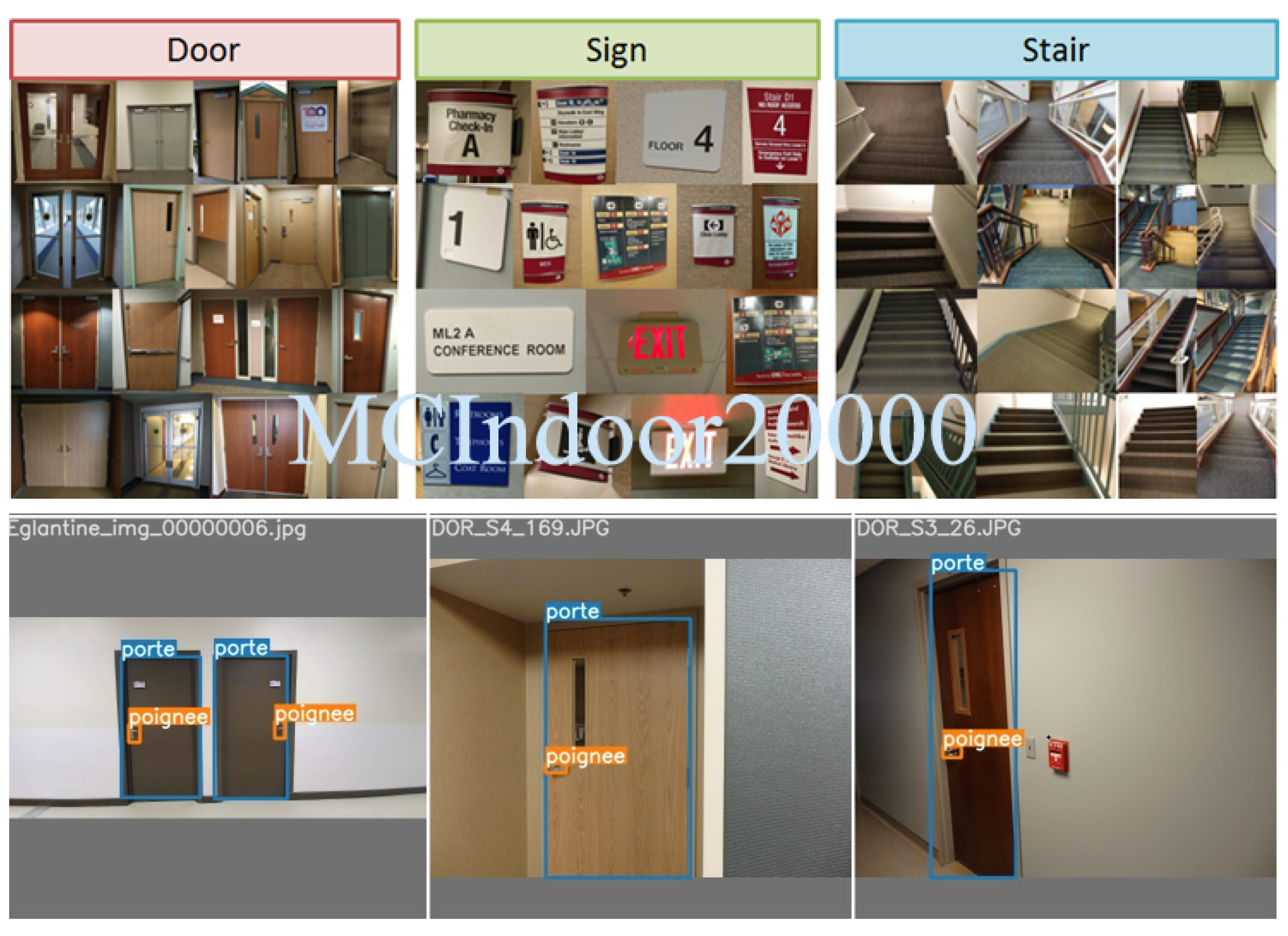
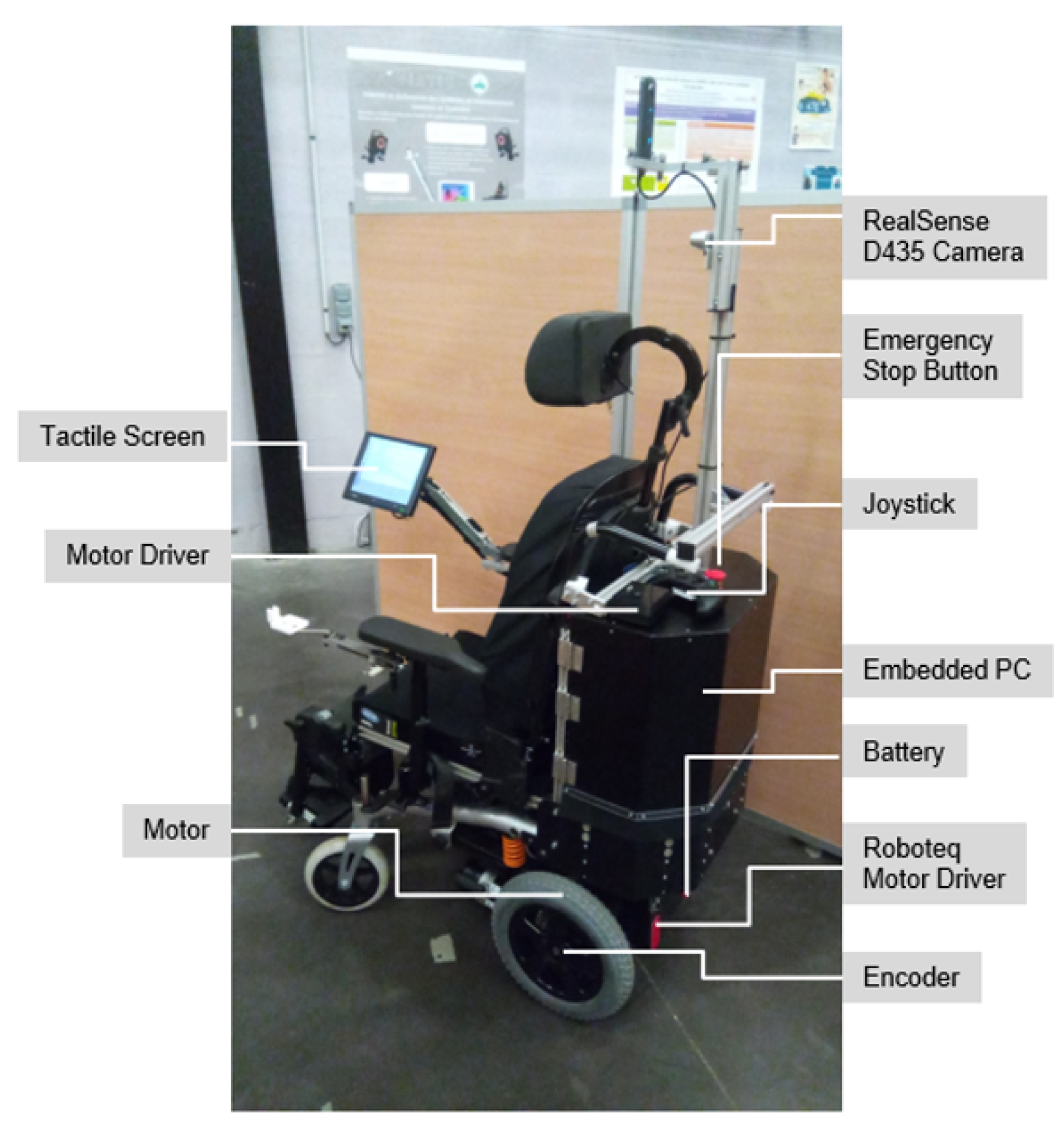


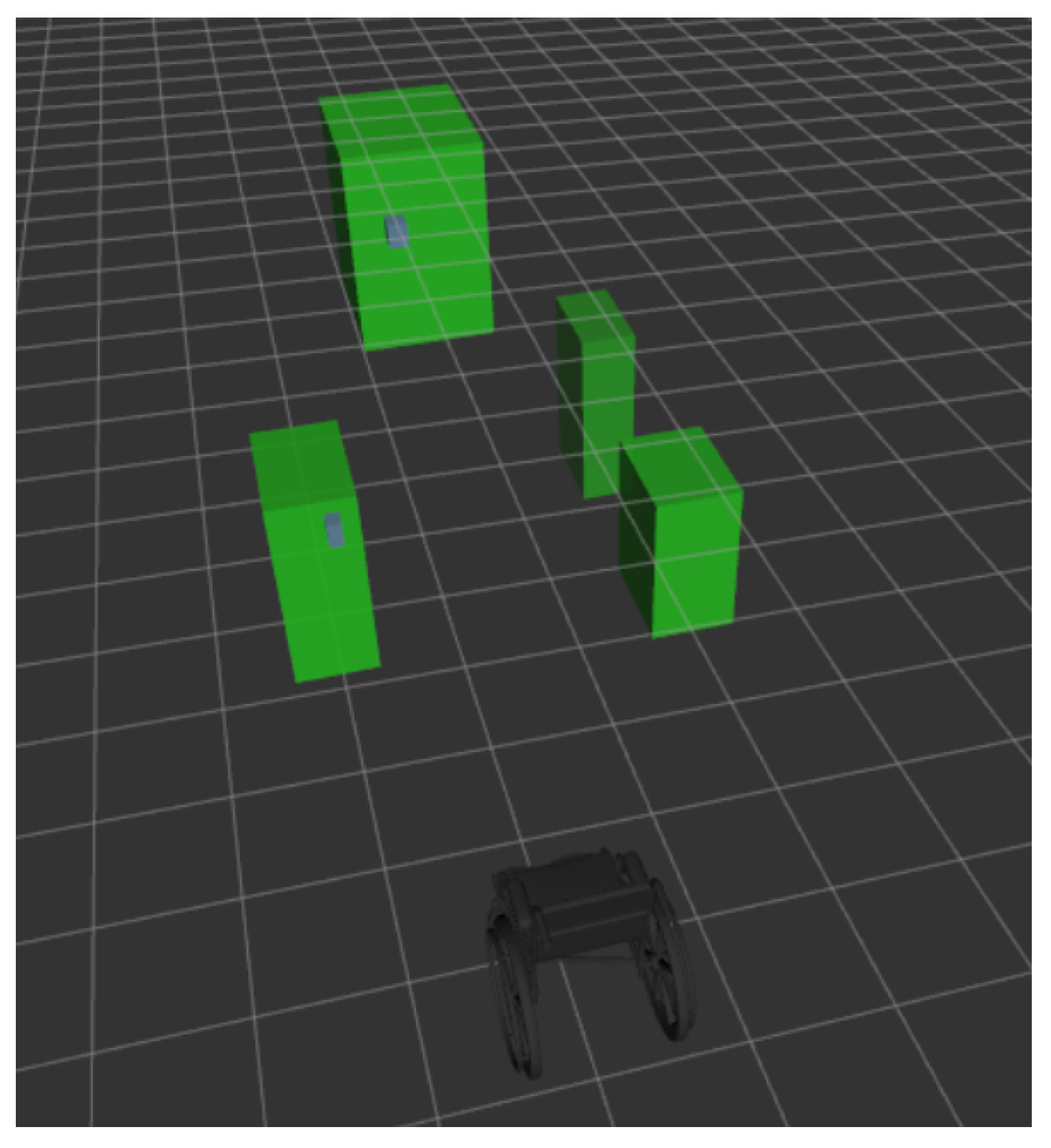
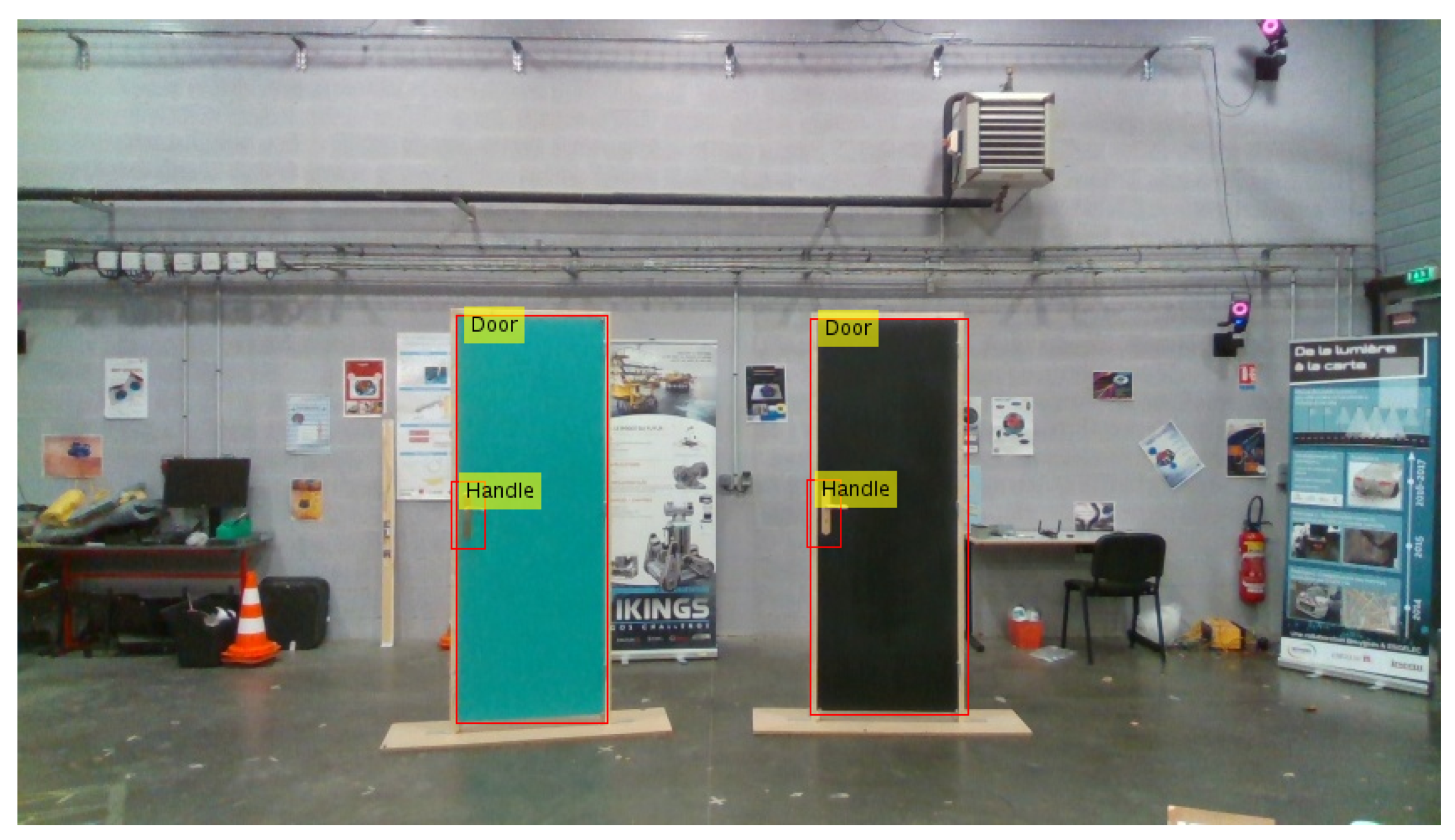

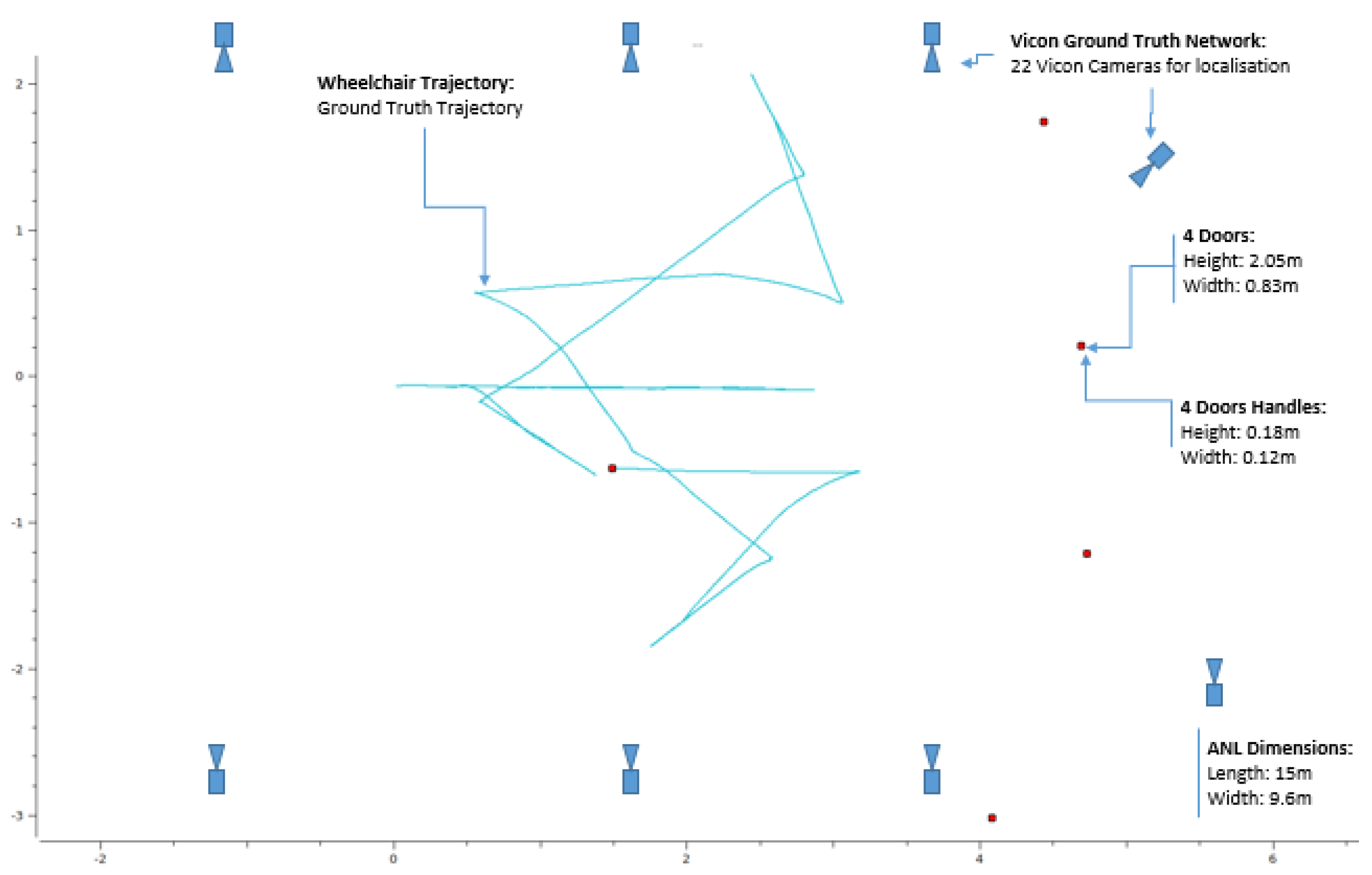
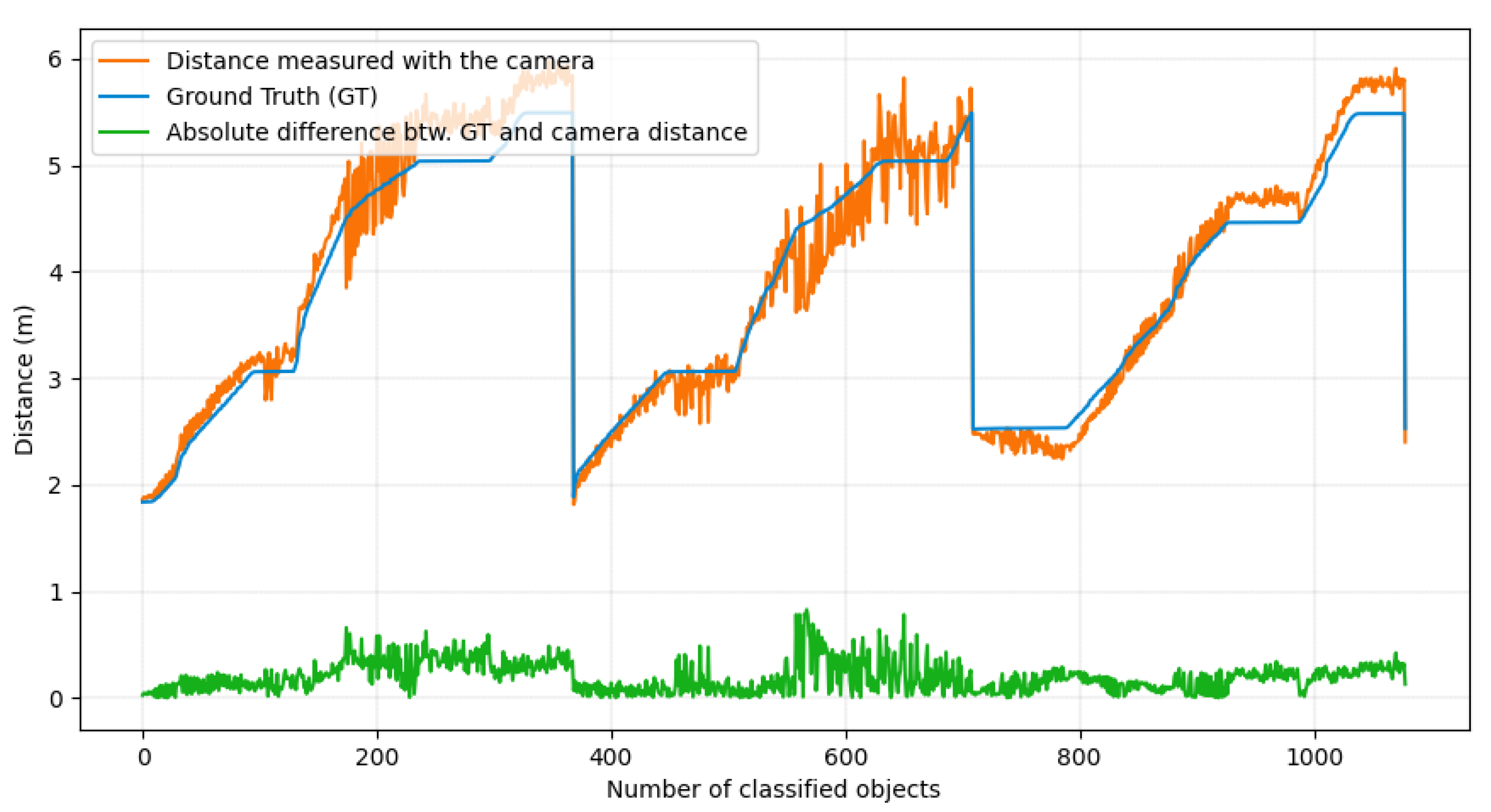
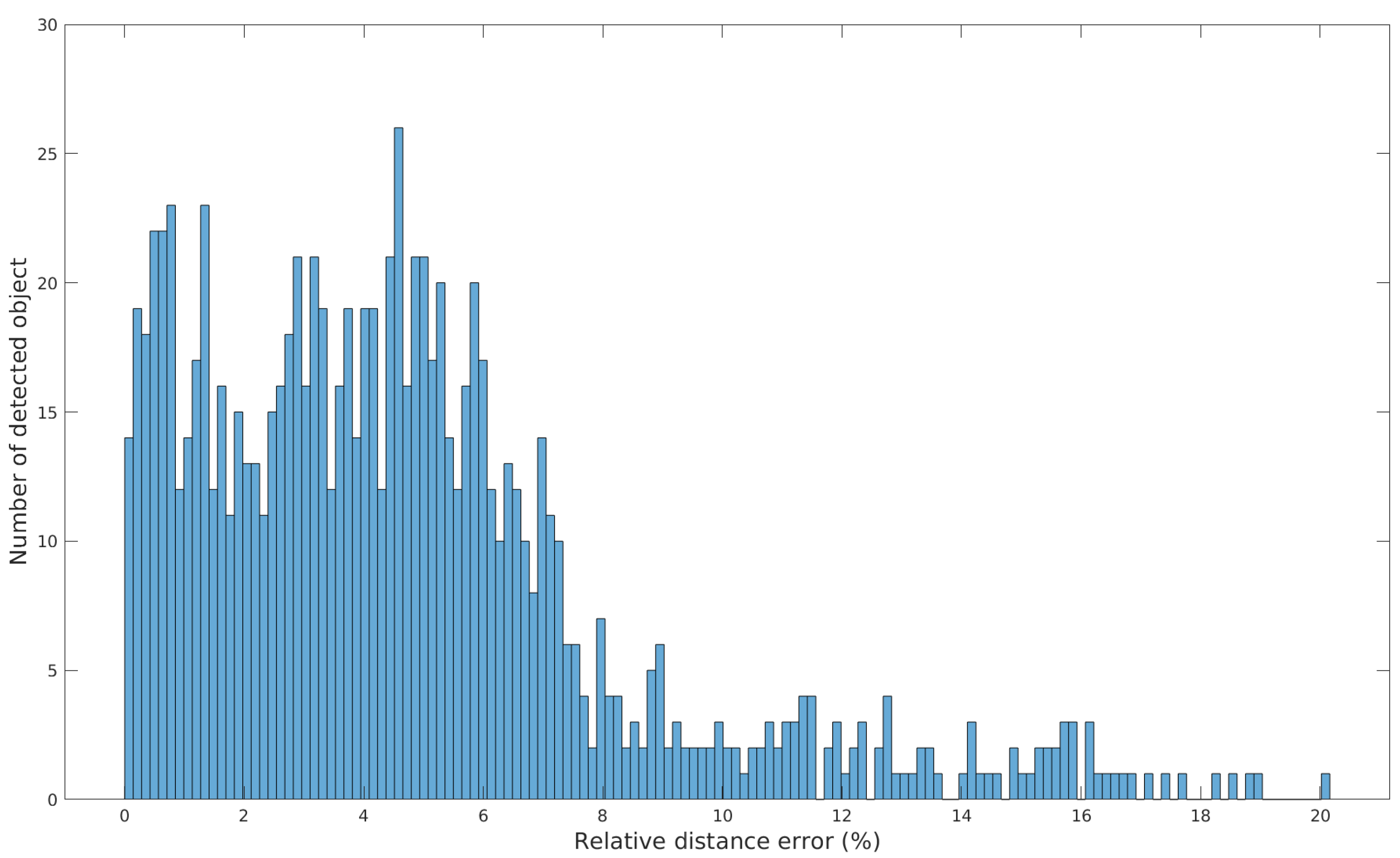
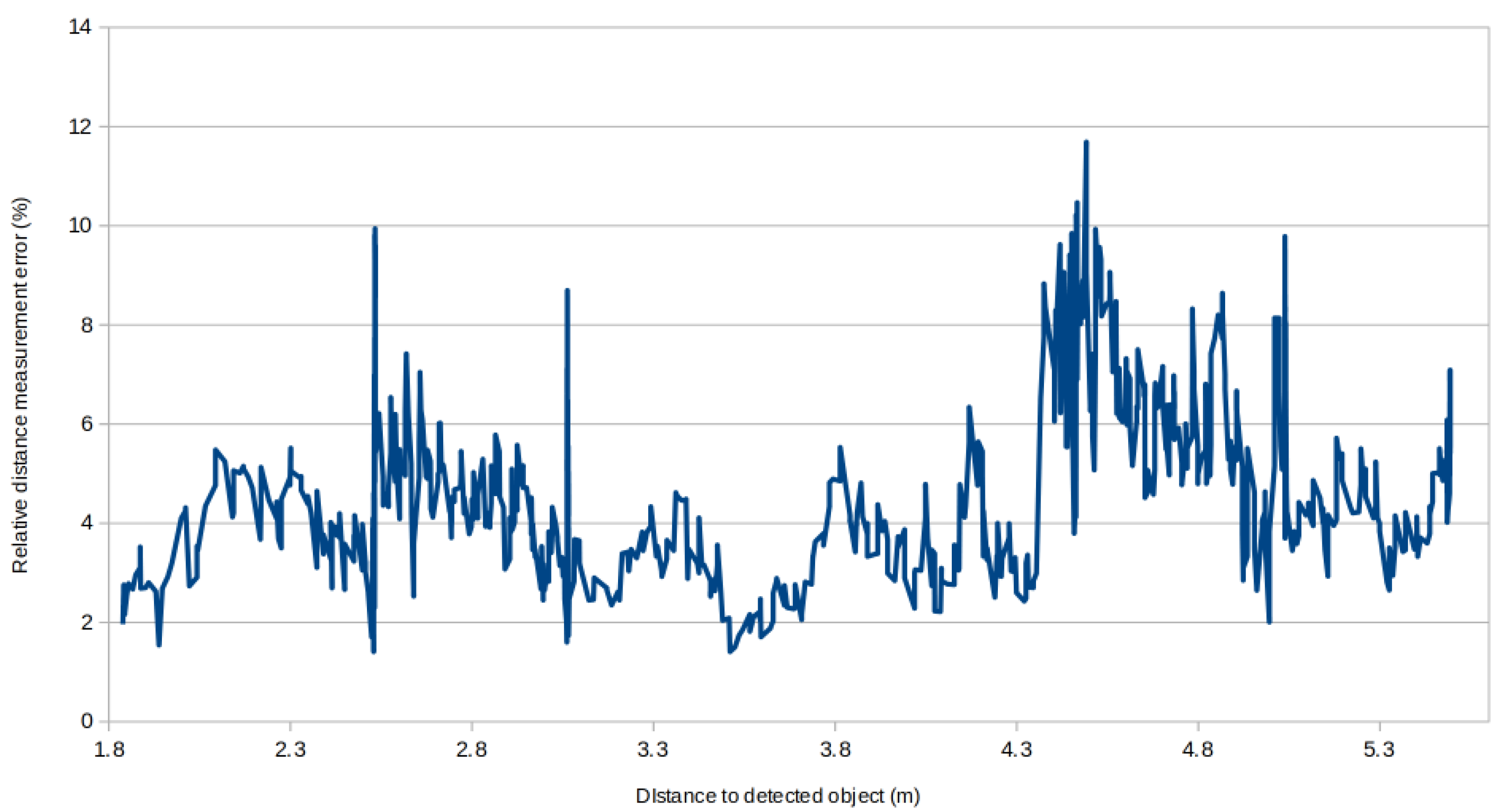
| Class | Mean IOU | Median IOU | Std. Dev. IOU | Precision (%) | Recall (%) |
|---|---|---|---|---|---|
| door | 0.89 | 0.89 | 0.05 | 0.90 | 0.80 |
| handle | NA | NA | NA | 0.85 | 0.29 |
| Depth Estimation Error | |
|---|---|
| Median (cm) | 15.6 |
| Average (cm) | 18.1 |
| Standard deviation (cm) | 13.5 |
| Median (%) | 3.2 |
| Average (%) | 3.8 |
| Standard deviation (%) | 2.6 |
Publisher’s Note: MDPI stays neutral with regard to jurisdictional claims in published maps and institutional affiliations. |
© 2020 by the authors. Licensee MDPI, Basel, Switzerland. This article is an open access article distributed under the terms and conditions of the Creative Commons Attribution (CC BY) license (http://creativecommons.org/licenses/by/4.0/).
Share and Cite
Lecrosnier, L.; Khemmar, R.; Ragot, N.; Decoux, B.; Rossi, R.; Kefi, N.; Ertaud, J.-Y. Deep Learning-Based Object Detection, Localisation and Tracking for Smart Wheelchair Healthcare Mobility. Int. J. Environ. Res. Public Health 2021, 18, 91. https://doi.org/10.3390/ijerph18010091
Lecrosnier L, Khemmar R, Ragot N, Decoux B, Rossi R, Kefi N, Ertaud J-Y. Deep Learning-Based Object Detection, Localisation and Tracking for Smart Wheelchair Healthcare Mobility. International Journal of Environmental Research and Public Health. 2021; 18(1):91. https://doi.org/10.3390/ijerph18010091
Chicago/Turabian StyleLecrosnier, Louis, Redouane Khemmar, Nicolas Ragot, Benoit Decoux, Romain Rossi, Naceur Kefi, and Jean-Yves Ertaud. 2021. "Deep Learning-Based Object Detection, Localisation and Tracking for Smart Wheelchair Healthcare Mobility" International Journal of Environmental Research and Public Health 18, no. 1: 91. https://doi.org/10.3390/ijerph18010091
APA StyleLecrosnier, L., Khemmar, R., Ragot, N., Decoux, B., Rossi, R., Kefi, N., & Ertaud, J.-Y. (2021). Deep Learning-Based Object Detection, Localisation and Tracking for Smart Wheelchair Healthcare Mobility. International Journal of Environmental Research and Public Health, 18(1), 91. https://doi.org/10.3390/ijerph18010091






